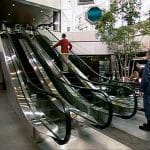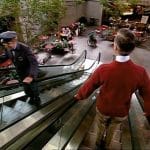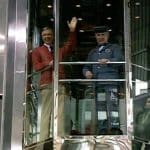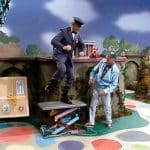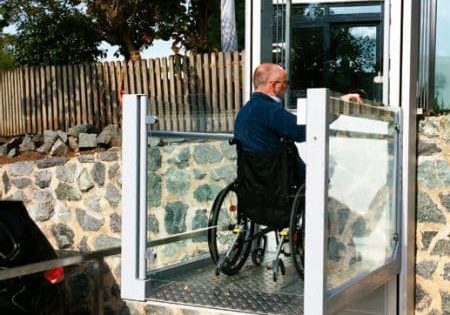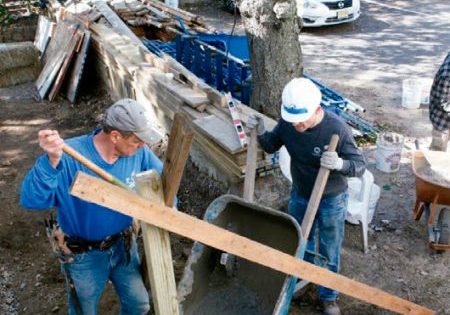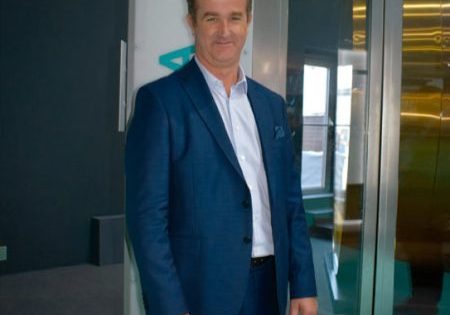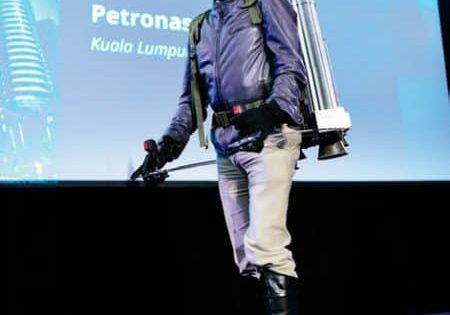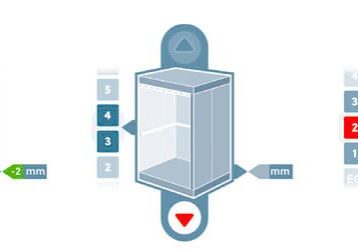Up and Down in Mister Rogers’ Neighborhood
Feb 1, 2020

One episode of TV icon Fred Rogers’ venerable program addressed vertical transportation in a way only he could.
by Dr. Lee Gray, EW Correspondent
A Beautiful Day in the Neighborhood, starring Tom Hanks and Matthew Rhys, opened in theaters on November 22, 2019. The movie was the subject of numerous articles and reviews, all of which emphasized the film’s positive message, conveyed through Hanks’ portrayal of Fred Rogers, who personified kindness, honesty and decency. Mister Rogers’ Neighborhood debuted on February 19, 1968, and educated and entertained children for 33 years, with the final episode broadcast on August 31, 2001. One of the program’s defining characteristics was its slow pace, clear focus on one idea per show and Rogers’ ability to speak directly to his audience. In the first episode of season 23, which aired on November 23, 1992, Rogers turned his attention and patient sensibility to the world of elevators and escalators.
Episode 1656 of Mister Rogers’ Neighborhood, “Mister Rogers Talks about Up & Down,” opened, as always, with Rogers entering his house singing, “Won’t You Be My Neighbor?” This time, he also entered carrying a green-painted children’s toy, which he placed on the familiar bench where, after donning his trademark sweater, he sat to replace his loafers with tennis shoes. The toy, which fan websites have identified as a Fisher- Price Play Family Action Garage, featured an elevator operated by a hand crank (Figure 1). After demonstrating how the elevator carried toy cars up and down, Rogers reminded his audience, “There are real machines that lift real things like cars and people up and down, and, you know, they’re called elevators.” He then informed his viewers, “Mr. McFeely said he would come by today and take us to a place that had special things that take people up and down.” McFeely was the primary employee of Speedy Delivery Co. However, on this occasion, his role was to introduce Rogers and his audience to machines that went up and down.
After McFeely’s arrival, Rogers asked him to demonstrate “up and down” by walking up and down the entry stairs, after which McFeely informed him, “The place I’m going to take you has stairs that move all by themselves.” The pair’s journey was depicted by the camera following a path through the scale model that represented the neighborhood, beginning with Rogers’ house and ending at a tall building. This model, which depicted One Oxford Centre in downtown Pittsburgh, was apparently added to the neighborhood specifically for this episode. In addition to the building, the model also included the entry plaza and a representation of a large curving planar sculpture (North Light by American artist David von Schlegell). This subtle touch, which was doubtless unnoticed by most viewers, serves as a reminder of the realistic way Rogers imagined the world he created for his program.
After the camera focused on the outside of the model, the scene dissolved. McFeely and Rogers were then shown walking across the plaza and entering the building. One Oxford Centre, designed by HOK (then Hellmuth, Obata + Kassabaum), opened in April 1983. The 45-story tower included a ground-floor food court and four floors of shopping. Access to the stores was provided by escalators and two direct-plunger hydraulic elevators with glass cars. The elevators also employed colorful, decorative banners below the cars that screened the plungers. All the building’s elevators and escalators were manufactured by Westinghouse.
Rogers’ visit begins with an examination of the twin escalators that lead to the second-floor shops. After McFeely notes, “This side goes up, and that side goes down,” Rogers replies, “Well, should we just go up and down?” McFeely responds, “Oh, you can, but I just want to show you a few things first.” This is followed by a brief lesson on how to ride an escalator. After pointing out the presence of the moving handrail, McFeely provides instructions where to place your hand and where to stand: “Remember to put your hand right on top; don’t curl your fingers underneath; put your hand right on top. Now here are the steps. They’re moving steps; see how they separate? Now, when you go up, put your hand on the handrail, and step right in the middle of the step.” Rogers then carefully steps onto the escalator and rides up with both hands atop the handrails, while he stands in the center of the step (Figure 2). After he reaches the top, he immediately boards the adjacent descending escalator. As he descends, McFeely rides up (Figure 3). Rogers observes McFeely is “holding on just the way you told me,” and he reminds him, “Watch your step when you get off.”
The origins of McFeely’s safety instructions are unknown. Given the fact that that “moving stairs,” when encountered for the first time, often fascinate (or frighten) children, it is not surprising to find that instructions were provided on how to safely ride an escalator. The inclusion of this content also coincides with the educational goals of Mister Rogers’ Neighborhood. However, when McFeely and Rogers turn their attention to the building’s twin glass elevators, no instructions are provided on their use. Fred Rogers and others associated with his program may have assumed elevators posed no discernable safety risks for children. This perhaps understandable, but wrong, assumption is one of the few flaws in an otherwise excellent program.
After observing the glass elevators moving up and down, McFeely and Rogers walk to the elevator lobby, where Rogers is told to push the up button. This action prompts what may be viewed as a subtle lesson in patience when McFeely says, “Sometimes you have to wait for elevators,” and Rogers (laughing) replies, “I’ll say.” The pair ride the elevator up to the third floor and back down to the first, observing the food court atrium through the glass wall, while Rogers waves to people below (Figures 4 and 5). Following the brief elevator ride, McFeely and Rogers exit the building and return to Rogers’ house, where McFeely departs to make a “speedy delivery.”
After entering the house, Rogers says “let’s make-believe about some other things that go up and down in our pretend neighborhood.” The scene then shifts to the Neighborhood of Make-Believe, which is primarily inhabited by puppets voiced by Rogers. The first “thing that goes up and down” highlighted in this segment is a hand-powered elevator associated with the factory of Cornflake “Corny” S. Pecially. Corny manufactures “Rockits” (rocking chairs) and asks Handyman Negri (one of the few human inhabitants of the make-believe neighborhood) to use the elevator to raise and lower two Rockits (Figure 6). McFeely makes a second appearance on the program when he arrives to deliver another machine that demonstrates the idea of up and down. With the aid of Handyman Negri, he delivers a portable hydraulic platform lift (described as having been manufactured by Up and Down Co.) to Lady Elaine Fairchilde at the Museum-Go-Round. This machine illustrated the variety of devices that carry things up and down. However, its demonstration, in which Handyman Negri and McFeely take turns riding on the lift (with the latter standing on one foot as he descends) was not, perhaps, as safety conscious as it could have been (Figure 7).
The visit to One Oxford Center and the demonstrations of the toy elevator, the model hand-powered elevator and the hydraulic platform lift occupied 13.5 min of the program’s 30-min length. The remaining time was filled with songs and other demonstrations of “up and down” (including climbing stairs and raising arms and eyebrows up and down). The slow, steady and clear presentation of this material, coupled with Rogers’ ride on real escalators and elevators, doubtless served as a good introduction to this subject.
The appearance of vertical transportation in Mister Rogers’ Neighborhood serves as yet another reminder of its powerful cultural presence. But, and perhaps more importantly, the genuine and gentle humanity that shines through Rogers’ performance serves as a reminder that it is possible to live in the modern world in peace and harmony if you are willing to try. This simple fact is why this program ended, as did every episode, with the song “It’s Such a Good Feeling.” The song reminds us:
“It’s such a good feeling To know you’re alive.
It’s such a happy feeling:
You’re growing inside.
And when you wake up ready to say, ‘I think I’ll make a snappy new day.’”
A message clearly aimed at children but far from a childish thought.
- Figure 1: Rogers demonstrating the elevator in the toy garage © The Fred Rogers Co., 2010[1]
- Figure 2: Rogers riding the escalator in One Oxford Center © The Fred Rogers Co., 2010[1]
- Figure 3: Rogers and McFeely riding the escalators in One Oxford Center © The Fred Rogers Co., 2010[1]
- Figure 4: Glass Elevators in One Oxford Center © The Fred Rogers Co., 2010[1
- Figure 5: Rogers and McFeely riding in a glass elevator in One Oxford Center © The Fred Rogers Co., 2010[1]
- Figure 6: Handyman Negri operating the hand-powered elevator at Cornflake “Corny” S. Pecially’s Rockit Factory © The Fred Rogers Co., 2010[1]
- Figure7: Handyman Negri and McFeely demonstrating the operation of the hydraulic platform lift © The Fred Rogers Co., 2010[1]
Reference
[1] Mister Rogers’ Neighborhood. Episode 1656, “Mister Rogers Talks about Up & Down” (November 23, 1992).
Get more of Elevator World. Sign up for our free e-newsletter.

